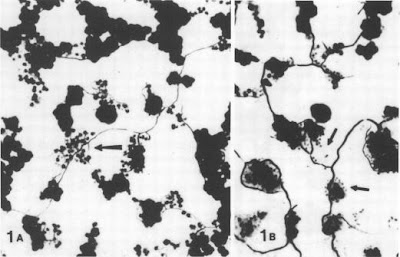Deadly Mycelia: Predatory Streptomycetes
Streptomycetes are often viewed as friendly, soil-dwelling saprophytic bacteria —feeding on dead or decaying matter. But, actually, some of them are pathogenic agents. For instance, Streptomyces scabies is responsible for the common scab of potatoes and other root crops. And some streptomycetes are able to cause human diseases called actinomycetomas, or actinomycotic mycetomas. An example is Bouffardi's white mycetoma, produced by Streptomyces somaliensis. Nevertheless, most actinomycetomas are generally caused by other, non-Streptomyces actinomycetes such as Nocardia and Actinomyces.
Despite their potential negative effects on our health or our economy, streptomycetes are mostly notable because of their ability to produce useful compounds (antibiotics, antitumor, immunosuppressive drugs...) and industrial enzymes (proteases, xylanases, cellulases...). Of course, the term "useful" can be understood only under our human point of view. Imagine that you are a soil microbe, living in close proximity to a streptomycete. You probably don't like your neighbor: it produces antibiotics and other substances that may affect your growth or even kill you and, if the worse happens, the damned streptomycete is well equipped with digestive enzymes to feed on your carcass. It is really an awful neighbor. Under your point of view, the word "saprophyte" does not make it justice at all. But, would you call it a "predator"?
A recent report, available from Nature Precedings [1] although not yet published in a peer-reviewed journal, suggests that actinomycetes, and streptomycetes in particular, are non-obligate predators of bacteria in soil. This assertion is based on the following evidences:
The report proposes that predatory abilities are widespread within the Streptomyces genus. Previous studies described predatory activities for a few actinomycetes, including some streptomycetes [2-6]. In one of the early studies [6], Micrococcus luteus cells (the "prey") were applied to slides which were then buried in natural soil, either outdoors or in the laboratory. At different times, the slides were stained and observed microscopically, searching for natural soil predators. The M. luteus cells were attacked by two different bacteria from soil: one of them was a gram-negative one (later known as Ensifer adhaerens), while the other one was a streptomycete, which was named "strain 34". The following description derives from the microscopic observations of soil-buried slides (see picture) [6]:"Under nutritionally poor conditions in soil, strain 34 sought out host cells [Micrococcus luteus] by extending a slender filament of mycelium. If this mycelium found host cells, it attacked them. If it did not, it lysed. Only one strand of mycelium actually connected any two packets of M. luteus cells under attack, although more than one strand could radiate from a given packet to other packets. This would appear to represent some sort of conservation of mycelium."
Analogous observations were made with a pure culture of strain 34 (isolated from the soil-buried slides) and agar media containing M. luteus cells [6]:"On Noble agar, strain 34 mycelium attacked M. luteus cells in a manner similar to that in soil. However, it would seem that although there was mycelial contact with the host cells, the actual mechanism of lysis was through elaboration of a soluble, diffusible lytic agent. This was inferred because on nutritionally richer media lysis of the M. luteus cells occurred at a distance beyond the limit of mycelial extension"
Therefore, it is possible that many soil actinomycetes (particularly, streptomycetes) are predators of bacteria. It may well be that streptomycetes are able to recognize some diffusible substances secreted by their possible preys. Growth of a (specialized?) filament of mycelium may be stimulated by such substances; as a result, the filament approaches the target microbe. Then, the predator secretes its own diffusible poisons (antibiotics, enzymes?) that, eventually, lyse the prey cells. The released cellular contents are now ready to be degraded and taken up by the streptomycete.
Evidently, further research is needed for a better understanding of the ecological role of actinomycetes in soil, and the natural function of antibiotics (and other secondary metabolites). Under an applied point of view, it suggests a possible way to induce the expression of "silent" gene clusters in streptomycetes and, hence, discover new secondary metabolites: by co-culturing with potential preys.
Links:
Predatory actinomycetes
[1] Streptomyces sp. as predators of bacteria. Charushila Kumbhar and Milind Watve. Available from Nature Precedings (2007).
[2] Nonobligate bacterial predation of bacteria in soil. LE Casida Jr. Microbial Ecology (1988) 15, 1-8.
[3] Gram-negative versus gram-positive (actinomycete) nonobligate bacterial predators of bacteria in soil. LR Zeph, LE Casida Jr. Appl Environ Microbiol (1986) 52, 819-823.
[4] Interaction of Agromyces ramosus with other bacteria in soil. LE Casida Jr. Appl Environ Microbiol (1983) 46, 881-888.
[5] Ensifer adhaerens predatory activity against other bacteria in soil, as monitored by indirect phage analysis. JJ Germida, LE Casida Jr. Appl Environ Microbiol (1983) 45, 1380-1388.
[6] Bacterial predators of Micrococcus luteus in soil. LE Casida Jr. Appl Environ Microbiol (1980) 39, 1035-1041.
Predatory bacteria
- Predatory Behaviors in Bacteria - Diversity and Transitions. Edouard Jurkevitch. Microbe (2007) 2, 67-73.
- Top Bug. Discover Magazine (03.01.1993).
- Martin’s Microbial Menagerie. Mark O. Martin. University of Puget Sound.
Pathogenic streptomycetes
- Streptomyces: not just antibiotics. Rosemary Loria, Madhumita Joshi and Simon Moll. Microbiology Today, May 2007 - Actinobacteria.
- Streptomyces scabies. Brooke Edmunds. North Carolina State University.
- Common Scab of Potato. Michigan Potato Diseases.
- Actinomycetoma and Mycetoma. Medical Dictionary at TheFreeDictionary.
- Bouffardi's white mycetoma. MedicineWord.
- Actinomycetoma vs. Melanoma. In Tropical Diseases vs. Cosmopolitan Diseases: IX. Mycetomas. Dr. K. Salfelder & Dr. E. Sauerteig.
- Mycetoma : a review. V. Lichon, A. Khachemoune. Am J Clin Dermatol (2006) 7, 315-321.
- Mycetoma. DermNet NZ.
- Pathogenic Microbiology: Actinomycetes. University of Maryland.












